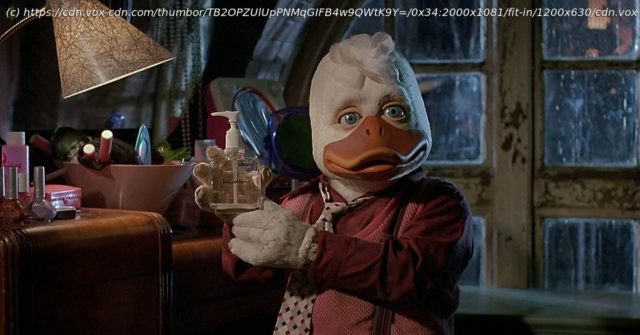Here’s a bit of Marvel movie trivia: without the Star Wars director’s Howard the Duck movie from the 1980s, the Wachowskis would never have had the technology to make The Matrix. Here’s how one of the biggest flops, wuxia films, and wire work started a small revolution.
When you read chronicles of the movie industry’s legendary flops, they almost always include Howard the Duck, the 1986 Marvel Comics adaptation that cost $37 million and tanked hard at the box office.
The iconoclastic Marvel comic written by Steve Gerber became an unlikely pop culture phenomenon in the mid-1970s, and George Lucas discovered it in film school. By the ’80s, though, Gerber’s creation was mostly forgotten — except by Lucas. The director-producer chose Howard the Duck as one of his post-Star Wars marquee production projects, directed by his old friend and American Graffiti co-writer Willard Huyck.
But from the ashes of failure often rise future successes. This oddball flick about a dimension-warped anthropomorphic waterfowl gave rise to a special effects technique that revolutionized the way action cinema was made. We wouldn’t have The Matrix without Howard the Duck.
In the 1980s, Industrial Light & Magic was where the special effects magic happened. Lucas founded the company because he wanted the original Star Wars to feature visuals that no other sci-fi film had pulled off before. A New Hope’s space battles were created using a PDP-11 computer that precisely moved a camera rig around detailed miniature models. It recorded its movements and replayed them exactly, allowing for multiple shots to be composited together while maintaining placement and perspective. This revolutionized how effects scenes were choreographed, and placed the computer at the heart of Lucas’ toolkit. It wasn’t long before ILM’s attention turned to using the machines to alter the film itself.
ILM’s projects were often used as proofs of concept for new technology, and Howard the Duck was no exception. The movie was packed full of ambitious effects, from the “Go Motion” technique, used to create the realistic blurring of the film’s sculpted miniature Dark Overlord monster, to the wireless controls for Howard’s facial animation. But arguably the film’s most important effect was something that didn’t even show up on the screen.
Howard the Duck’s quite literal breakthrough came right at the beginning, in a scene in which the duck is rocketed out of his apartment along with his easy chair. The effect was filmed with steel wires pulling the puppet and prop horizontally through multiple walls and sets, but it was what came after the camera stopped rolling that made it truly revolutionary.
Everything George Lucas has said about his theoretical Star Wars sequel trilogy
Wire suspension was nothing new in special effects work. Classics like Metropolis (1927) and King Kong (1933) simulated the flights of airplanes by moving tiny models across barely visible strands of steel. Actors could also be strapped into harnesses to simulate flight, a technique adopted from the stage.
Over in Hong Kong, directors were even more ambitious with their wires. To augment their already impressive agility, performers were harnessed up to wires for heroic leaps and gravity-defying kicks. The technique defined the wuxia films of the 1960s, but if you squint, you can often see the telltale cords suspending the heroes and villains.






